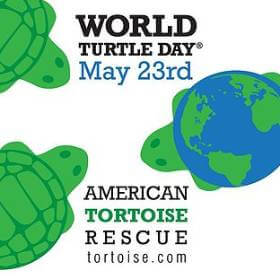May 23 is World Turtle Day
 Today is World Turtle Day, a holiday created in 2000 by non-profit organization American Tortoise Rescue (ATR) to celebrate turtles and tortoises and to protect their habitats.
Today is World Turtle Day, a holiday created in 2000 by non-profit organization American Tortoise Rescue (ATR) to celebrate turtles and tortoises and to protect their habitats.
Susan Tellem and her husband Marshall have rescued and re-homed more than 3,000 turtles since cofounding ATR in 1990. Ten years later, they started World Turtle Day because, as Susan told the Huffington Post, “Turtles are not as popular as cats and dogs, so interest, awareness and understanding is pretty slim. This day is a good way to educate people about how to care for turtles, and to learn what danger they’re in and how to be more aware of what they need.”
The oldest turtle fossil found to date was unearthed in 2007 in China’s Guizhou province. Discovered in rocks of the late Triassic Period, it is estimated to have lived 220 million years ago, during the age of the dinosaurs. It is considered a transitional creature, an aquatic turtle that had armor solely on its underbelly and a mouth full of teeth, earning it the name Odontochelys semitestacea (“toothed turtle with half-shell”). By comparison, human evolution dates back a mere 2.5 million years.
While researching the connection between dinosaurs and turtles, we noticed several groups that assert the planet is, in reality, only six thousand years old. Here, one website explains how it knows fossil records have been faked:
According to evolutionists, the dinosaurs “ruled the Earth” for 140 million years, dying out about 65 million years ago. However, scientists do not dig up anything labeled with those ages. They only uncover dead dinosaurs (i.e., their bones), and their bones do not have labels attached telling how old they are. The idea of millions of years of evolution is just the evolutionists’ story about the past. No scientist was there to see the dinosaurs live through this supposed dinosaur age. In fact, there is no proof whatsoever that the world and its fossil layers are millions of years old. No scientist observed dinosaurs die. Scientists only find the bones in the here and now, and because many of them are evolutionists, they try to fit the story of the dinosaurs into their view.
The contention that fossils were not buried with labels must be correct since they died before the existence of tombstones and Post-It notes (or did they?). If a person digs into a garbage dump and finds a ham sandwich ten feet down, mightn’t he surmise, even without the benefit of scientific instrumentation, that it is older than the one his mom made for him that morning, in spite of the fact that he has unearthed it in “the here and now?”
It’s also a fact that no scientist has observed a dinosaur live or die. The logic is indisputable. We’ll go on record and say that no one alive today has ever hung out with Abraham Lincoln. Very few of us have met Stephen King. Yet most of us are pretty sure of their existence, even though they aren’t mentioned in the Bible. (We don’t want spoil the surprise, but one of them is working on a new book right now!)
But we digress. Turtles and tortoises are remarkable animals. Both are cold-blooded, breathe air and lay eggs on land. Generally speaking, tortoises live on land, are poor swimmers and have stumpy feet suited to walking very slowly on land. Turtles spend their time in the water and have streamlined bodies and webbed feet or flippers they are unable to retract.
The illegal pet trade puts tortoises at risk; transportation stresses them and many die during shipment from Russia or other far-flung locations. To combat this problem and reduce the demand for illegal imports, ART urges people to refrain from buying them at pet stores and adopt instead from one of the country’s many turtle rescue groups. Petfinder is an excellent resource, too.
All sea turtle species are listed as endangered or threatened under the Endangered Species Act, mainly due to bycatch, accidental capture in fishermen’s nets and trawls. The National Oceanic and Atmospheric Administration (NOAA) studies aquatic environments, works to reduce bycatch and develops recovery plans with the goal of increasing sea turtle numbers until they can be removed from the list.
In the meantime, everyone can help by keeping the beach free of litter and watching out when boating in an area where turtles live. If you find a tortoise in the middle of the road, carry it to safety and be sure to point it in the direction it was headed. Otherwise, it will instinctively turn around and walk back into danger.
If you find a turtle and can’t release it into the wild, soak it in tepid water and put it in a box with a lid. Keep it away from pets, children and stressful noises; contact an organization like ATR to help you care for it until a pet rescue group can secure it.
If you’d like to learn more about these fascinating creatures, check out National Geographic‘s article about a newly-discovered giant Galápagos tortoise; Live Science‘s turtle facts; and Mother Nature Network‘s post about 19 weird and wonderful turtle and tortoise species.
Have a happy World Turtle Day!
![]()

 Today is World Goth Day, a holiday that celebrates the global influence of the Goth subculture on music, literature and art.
Today is World Goth Day, a holiday that celebrates the global influence of the Goth subculture on music, literature and art.

 Today is May Ray Day. Its goal is simple. If you look out your window and it’s sunny, go outside and enjoy it. (Common sense tip: If you’re in the middle of a business meeting or driving a car, wait for a more appropriate moment to step outside.)
Today is May Ray Day. Its goal is simple. If you look out your window and it’s sunny, go outside and enjoy it. (Common sense tip: If you’re in the middle of a business meeting or driving a car, wait for a more appropriate moment to step outside.)